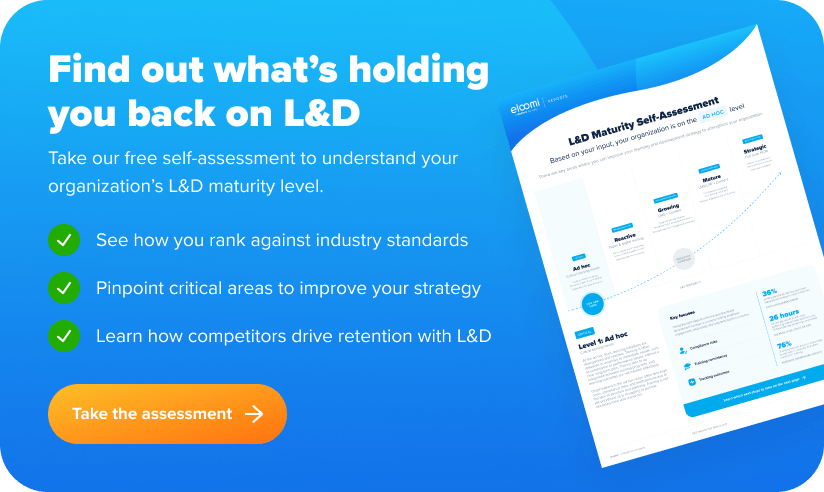What is the difference between learning vs training
When it comes to learning, we’ve all heard the statistic that people forget up to 90% of what they’re taught in sessions within the space of a week. It’s surprising to hear, but it’s important that our brains are able to forget in order to prevent information overload.
Of course, we know that techniques like repetition, breaking lessons down into chunks, or mixing it up by trying different learning approaches can help us break the forgetting curve. But at its core, success comes down to incorporating elements of both learning and training.
We’ve briefly covered the difference between learning vs training in our complete guide to LMS, but here we’re going to do a deep dive into the difference between learning and training – and why it’s so important for business. Let’s start with some definitions!
What is training
Training is defined as the act of teaching a person a particular skill, or skills, needed for a job or role. It’s geared towards training a person in something specific, usually over a limited or defined period of time.
For example, when someone starts in a new job, they typically undergo onboarding, where they’re ramped up with job-specific training in how to do their daily tasks, use specific tools, and how their department works. We can think of training as the specific skills or building blocks that make up the greater knowledge of a broader subject. For a chef, this might be knowing how to debone a fish, make a soufflé, or temper chocolate.
Training has the benefit of working towards concrete, discernible skills that will help someone immediately improve in their day-to-day tasks. However, it also comes with the drawback that it can miss the bigger picture.
What is learning
Learning is defined as the process of acquiring knowledge, or skills, through study or experience. Contrary to training, learning focuses on a person’s overall development rather than just their ability within a single role. Learning takes time, so it’s framed as a long-term process with emphasis on the continuous growth of the individual.
For example, in the workplace it may take years of learning and developing different skills for someone to become a pro in their role, or to start managing others. It can take experience, practice, and reflection to truly learn how to manage people, to know when you’ve found the right new hire for a job, or to deliver meaningful performance appraisal feedback. Our chef may know how to make the dishes, but they might not be ready to design the menu, cater a wedding, or run a team of staff.
Back in the world of business, all this makes learning sound like it must be too broad a concept to distill into trackable goals. Or even that learning might be something that happens passively: just sit in a role long enough and you’ll eventually learn what to do, but the reality is that although learning never ends, it needs a catalyst to start. And planning learning paths for your employees both sets them up for success and has enormous benefits for a company.

Learning vs training: the breakdown
Training
- Short-term
- Focus on the role
- Generic
- Specific skill
- Defined time frame
- Immediate need
Learning
- Long-term
- Focus on the person
- Personal
- Broad application
- Ongoing process
- Anticipating future need
Why it matters for business
Knowing how to train your employees, and what kind of training is the most effective, is one of the hardest parts of HRM. But it’s clear that companies need to employ a mix of both skills training and long-term learning to ensure best practice. If we only train skills using traditional methods, we invite forgetfulness, complacency, and risk missing the bigger picture. But in combination with development planning and blended learning, we can ensure that employees not only gain a toolkit of day-to-day skills, but also have a clear overview of their role, their goals, achievements, and their place within the company as a whole.
Writing for Forbes, HR analyst Josh Bersin says that businesses that incorporate alternative learning programs “outperform those that focus on formal training by 3 to 1. In these companies the corporate training team doesn’t just train people, it puts in place content and programs to help employees quickly learn on the job”. Notice the subtle difference between training and learning there? If businesses can nail not just short-term skills training, but also set employees on the path to long-term learning and development, then they’ll be on the path to success themselves.
Adopting a people development strategy has never been more urgent, with people leaving jobs like never before. A survey by Gallup-Amazon showed that up to 48% of US workers would be willing to change jobs if offered new skills training opportunities. Eagerness to learn and develop new skills is exploding across the market, and it’s clear that businesses offering meaningful training will be the ones to reap the rewards.
People are no longer satisfied with routine skills training, they want to grow, develop, and thrive in their role: they’re ready to learn.

Are you training people the right way?
The future of people development isn’t just a matter of learning vs training. It’s about looking at people: with their skills, interests, and long-term goals in mind. New generations expect to sit down and plan their career growth and creating new learning pathways is the first step in that process.
The good news is that this benefits your organization. Understanding the skills your talent pool possesses and being able to offer relevant training and long-term growth will allow you to retain employees, increase job satisfaction, and drive focus towards company goals.
If that sounds worth your while, get in touch with eloomi to explore the tools that can help you get the most out of the talent at your organization. It’s time to disrupt the way we’re used to thinking about learning vs training and start offering true people development.






